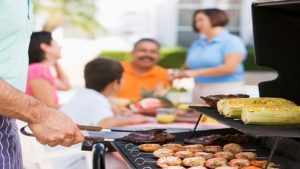Summer may be the traditional grilling season, but more than half of Americans are estimated to fire up the barbecue all year round! Whether you’re a seasonal griller or a year-round grill gourmet, beef up your food safety and nutrition with these helpful, hot-off-the-grill tips.
Develop a Taste for Safety
- Buy a Food Thermometer. When selecting a thermometer, read the package label. Be sure you’re buying a type designed to be used with food. There are many different types of food thermometers on the market.
- Clean Your Grill. Before throwing on your favorite food, ensure your grill is clean and ready for safe use. Clean your grill with hot, soapy water and remove any charred debris or grease buildup after each use.
Play It Safe
- Keep the Upper Hand. Proper food safety involves using different cutting boards when switching between raw meats and ready-to-eat foods. Remember to change your knives and other utensils when working with these foods, too, to avoid cross-contamination. Grilling shortcuts may save time, but they also can leave you with a case of foodborne illness! Take precautions. Wash cutting boards and utensils in hot, soapy water between uses. Or, use color-coded sets to separate raw meats, seafood poultry, and ready-to-eat foods. And always, always wash your hands!
- Embrace Marinating Musts. Marinate meat in the refrigerator (never on the counter or outside by the grill). If leftover sauces have been used on raw meat, discard them or bring them to a boil before reusing them to prevent cross-contamination.
- Prevent Charring. While there are neither federal guidelines on grilled meat consumption nor enough evidence connecting grilling meats to increased risk for cancers, there are ways to reduce the charring that typically occurs due to high-temperature cooking methods such as grilling, frying, and broiling. Cut off visible fat on meats, consider precooking meat and fish to reduce the juices that drip into the flame, and limit direct exposure of meat to open flames. Areas with charring can be scraped off before eating.
- Use Your Food Thermometer. While many Americans may have a food thermometer, only a tiny percentage consistently use it to check the doneness of their hamburgers, chicken breasts, and other grilled favorites. Using a food thermometer can help prevent overcooking and is the only way to ensure foods reach a safe internal temperature. Check out Tomah Health’s Safe Minimum Internal Temperature Chart by clicking here!
Be Adventurous
- Be Mindful of Fat. Choose lean cuts of beef, pork, poultry, or seafood. Plant-based protein foods, such as bean or tofu patties, can also be leaner options.
- Pile on the Nutrients. Add flavor and nutrition to your meal with vegetables on the grill. Baste vegetables such as peppers, corn, eggplant, or onions with a little olive oil or vinaigrette. Season them with herbs and place them on a hot grill until they are tender. Or sprinkle sliced zucchini, tomatoes, and carrots with a little water and seasoning, wrap in heavy-duty aluminum foil, and grill until vegetables are tender.
- Toast a Healthy Dessert. Grill fruit kebabs, pineapple slices, or peach halves on low heat until the fruit is hot and slightly golden. Serve the fruit on top of a scoop of low-fat yogurt for a tasty and nutritious dessert.
When You’re Chilling
- Watch the Clock. Refrigerate foods promptly, and don’t leave perishable foods sitting out for more than two hours at room temperature. When surrounding temperatures are 90°F or higher, the “two-hour rule” becomes the “one-hour rule.” Next time you dine outdoors, keep guests safe by setting out perishable food items in smaller portions and for one-hour shifts. Or, keep perishable foods on ice to ensure they stay correctly chilled.
- Remember the Condiments. Whether you’re using mayonnaise, salsa, ketchup, or mustard, remember condiments should not be left sitting out for more than two hours (one hour in temperatures above 90°F). Bringing a cooler or keeping condiments in a ice bucket is a bright idea.
- Let Leftovers Go. Keeping grilled foods for too long can affect their taste, quality, and, more importantly, safety. Food safety experts say grilled foods have a refrigerator life of only three to four days, so make sure your grilled leftovers are as safe as they are delicious. Refrigerate foods in shallow containers and write the date on top to help you keep track. Also, be sure to reheat foods before serving a second time and use a food thermometer to ensure they’ve reached an internal temperature of 165°F.
Works Cited “Fire up the Barbecue.” Www.eatright.org, www.eatright.org/food/food-preparation/seasonal-foods/fire-up-the-barbecue. Food Safety & Inspection Service, USDA. “Safe Minimum Internal Temperature Chart | Food Safety and Inspection Service.” Www.fsis.usda.gov, 11 May 2020, www.fsis.usda.gov/food-safety/safe-food-handling-and-preparation/food-safety-basics/safe-temperature-chart.
